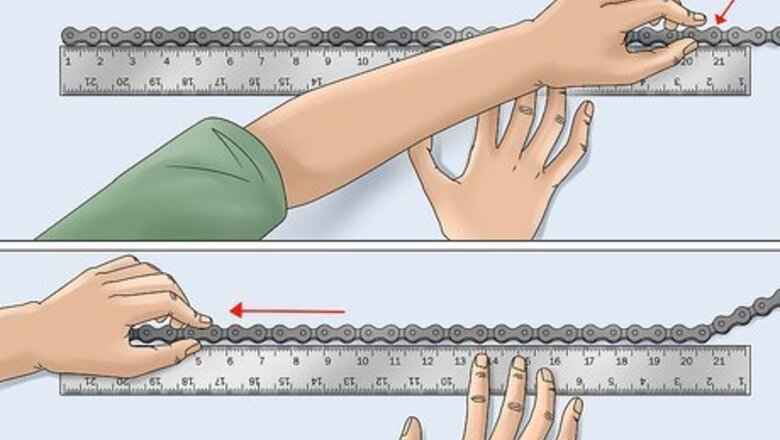
views
Removing the Chain
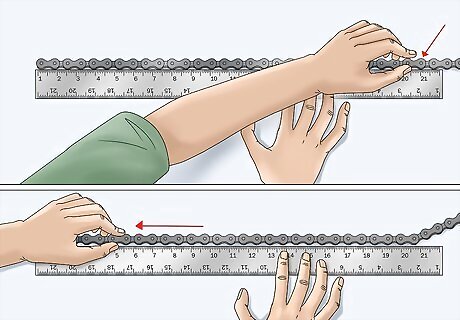
Determine whether the chain needs replacing. Count out 12 links, and measure them from the first pin to last pin. The distance between those pins should be 12 inches (30.48 centimeters). If the distance is more than 12 1/8 inches (30.80 centimeters), then you need to replace the chain. This is because pins are wearing out, lengthening the chain. If the distance between the 12 links is correct, and you have an older bike, consider loosening the back wheel and pulling it back. This may take up enough of the chain's slack to fix the problem.
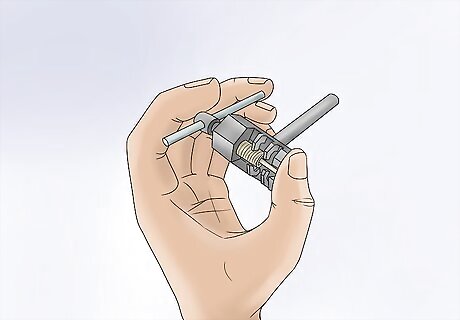
Purchase a universal chain tool if you don't have one. This tool pushes the pins out of your chain to allow link removal. If you know the make and model of your bike chain, you may prefer to track down a specialized tool for that specific chain. Some chains, notably most higher-end Shimano and Campagnolo models, also require a special reassembly pin. You cannot put the chain back together without this pin, so make sure you have the right part before you get started.

Mount the bike on a bike stand. If you do not have a bike stand, lean it against something sturdy, preferably upside down. This will make it easier to remove the chain.

Clean the chain if it is dirty. Use a high-quality, biodegradable chain cleaner or isopropyl alcohol to dissolve any dirt or grease. This will make it easier to handle the chain and find the master link.
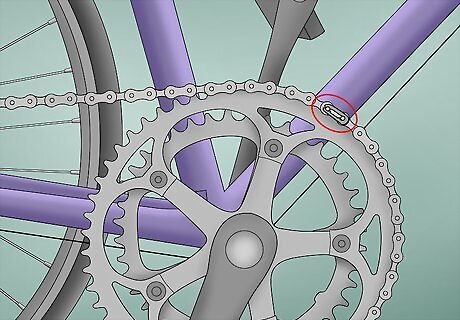
Locate the master link. Your chain may or may not have a master link. The master link is easy to spot because it is usually slightly lighter/darker than the other links on the chain. It may also have protruding pins inserted into a special outer plate. This plate typically has an oversize, oval hole around one or both pins.
Rotate the pedals until the master link is between the front and back gears. This will make it easier to access. If your chain does not have a master link, you'll have to use a chain tool to break the chain.
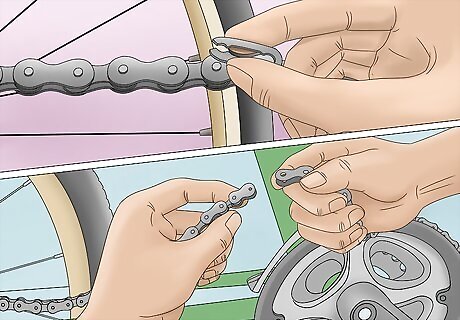
Open the master link, slide it off, and put it someplace where it won't get lost. There are many designs of master links. Some swivel to allow the pin to slide out, while others open up when flexed. Some master links are also disposable, and can only be removed by bending them apart with needle-nose pliers or a specialized tool. Check the side of the chain to find information about the make and model. Visit the manufacturer's website to find model-specific information about the master link.
Shortening the Chain

Decide how many links you need to remove. It's better to take off too few links at first than to take off too many. It'll be easier to take off an extra link or 2 than to add several links back on.
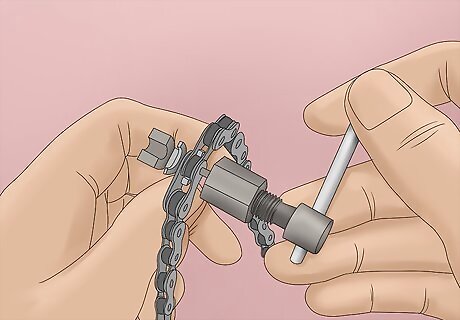
Clamp the next link of the chain. Start at the end of the chain not attached to the master link. Hold that link in place with a vise, or use the clamping mechanism on your chain tool if present. If your chain does not use a master link, start with any link on the chain.
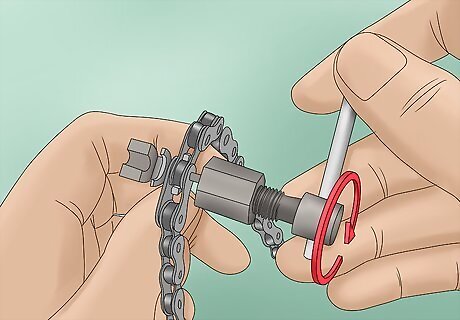
Push the pin most of the way out. Line up the punch on the tool over the link's pin. Slowly turn the handle on the chain tool clockwise and stop when the pin is clear of the outer plate but still attached to the link. Do not push the pin completely out of the link! In many cases, you will not be able to replace the pin if you push it completely out of the link. However, some manufacturers (including Shimano and Campagnolo) make replacement pins, but not all pins are compatible with all chains. If you did accidentally push the pin all the way out, you may be able to slide the pin through the center of the link. Use the chain tool to remove the upper part of the joining link then slide the pin back through the link until the top of the pin is flush with the center part of the link. Replace the top part of the link, then use the chain tool to push the pin back up. Adjust the adjacent pin as necessary.
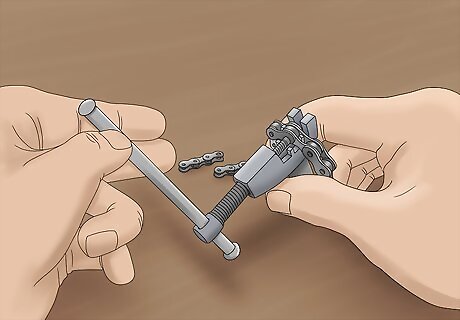
Repeat for the second pin and disassemble the link. Move on to the other pin in the same link. Push this out far enough that you can lift away one of the outer plates, followed by the central piece attaching it to the next link.
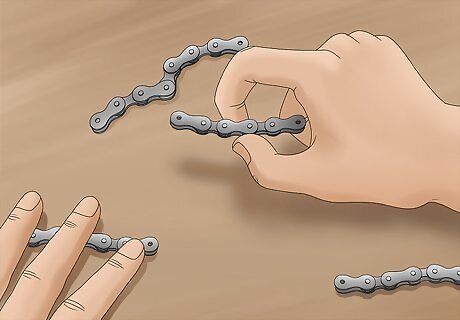
Remove additional links to shorten the chain. Only remove the minimum number of links to make your chain work -- generally less than 5. The more you shorten the chain, the more stress you'll put on the links. As before, leave the pins partially attached and set aside all components. Consider saving the chain links you are removing for future repairs.
Reassembling the Chain

Place the master link onto both ends of the chain. You may need to use some pliers or a screwdriver in order to do this. Push the 2 links together until you feel the pins click into place in the inner link. If your chain has a disposable master link or special pin, you'll need a replacement part to reattach the chain. Most of these special pins come in 2 parts that enter from opposite sides, but it's best to look for model-specific instructions.

Reconnect the chains using the chain tool. Place the 2 links back into the chain tool's outer slot. Make sure that the pins are facing toward the chain tool's pin. Turn the handle counterclockwise. As you turn, the chain tool's pin will start pushing the pins back through the link. Keep going until you can see a small portion of the link from the other side. The chain pin should be sticking out the same amount on both sides of the link. If you have a quick-release link, you may need a pair of pliers in order to replace it.
Reposition the pin, if necessary. Sometimes you'll need to work the chain from side to side to reposition the pin. To do this, grab either side of the stiff link tightly and gently work the chain perpendicular to its rotational direction until the link loosens.
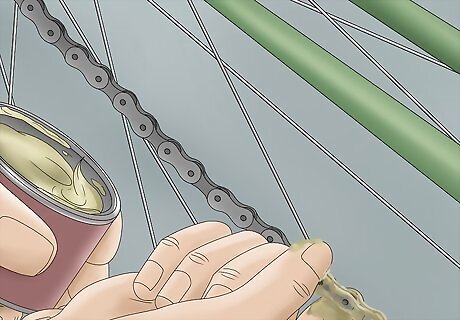
Apply a high-quality lubricant to the chain. This will increase the chain's lifespan and flexibility. It will also improve shifting performance, and reduce wear on derailleur assemblies and drivetrain cogs.














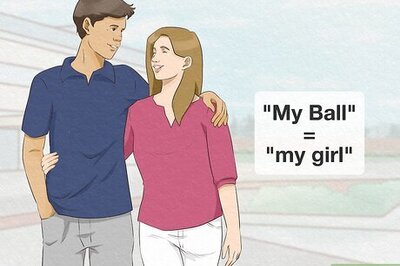



Comments
0 comment